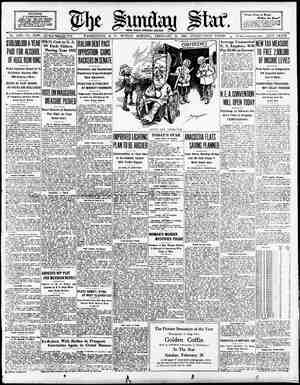Evening Star Newspaper, February 21, 1926, Page 14
You have reached the hourly page view limit. Unlock higher limit to our entire archive!
Subscribers enjoy higher page view limit, downloads, and exclusive features.
THE SUNDAY STAR, WASHINGTON, D. C, FEBRUARY 21, 1926—PART 1. 22 Years of Leadership and still Leading in Price ~Design ~ Quality Tudor - Fordor - Coupe - Touring Runabout - - New Price Old Price *580 660 520 290 260 520 565 500 310 290 All prices f.0.b. Detroit Supremacy Maintained through Features which Established Ford Leadership Multiple Disc-in-oil Clutch— The multiple disc clutch is generally conceded among engineers to be the best, Left-Hand Drive— Left-hand drive was originally introduced by Henry Ford on the Model T car in 1908. It caused a mild sensation in the motoring world, accustomed to nothing but right-hand drive and control—a featureadopted from abroad where the rules of the road are to drive to the left. The advantages of left-hand drive seemed so obviously better for the driving requirements of this country that the change was made. What has followed since in the industry, isa matter of common knowledge. Three Point Motor Suspension— This type of construction was: first used by Henry Ford in 1903, and has been a feature of the Model T power plant for eighteen years. The two rear supporting brackets of the engine are fastened to the frame, while the front bearing or trun- nion, is designed to allow sufficient movement to compensate for any twisting of the frame caused by road irregularities, thus protecting both the crankcase and crankshaft from distortion, and minimizing the possibility of repairs due to mis- alignment of engine bearings. The three-point principle is used throughout the car, including front and rear axles. Dual Ignition System— Dual ignition is provided for Ford cars, (1) the Ford magneto and (2) the generator and storage battery. This has been a great factor in establishing the Ford repu- tation for reliability. Even in remote sections where there is no battery service, the Ford owner may use his car without interruption—the magneto making him independent of battery current. Elimination of the magneto would reduce Ford production costs—but again Ford standards specify the additional value. Planetary Transmission— This type of transmission was used in the Ford six-cylinder car built in 1907. It was 80 successful that it was adopted for the Model T car. The Ford planetary transmission is the ideal speed control for a light car. It gives complete control through foot pedals and leaves the driver’s hands free to manipulate the steering wheel. Since the gears are constantly in mesh, there is no possibility of clashing ; speed changes are made instantly and noiselessly. This transmission costs more tobuild than the conventionalsliding gear typebutisused becauseof itssuperiority. the smoothest, and the most reliable type for any car. The Ford multiple disc clutch, has the further advantage of operating in a bath of oil. This com- plete and continuous lubrication assures smooth, silent action and extremely long life. The Ford clutch is so simple and reliable that many Ford owners have driven for years without being so much as conscious of its presence in the mechanism of their cars. Thermo-Syphon Cooling System— The circulation of water in Ford cars is entirely governed by engine temperature —the flow starting as the motor warms, and being most rapid at the points of greatest heat. On cold mornings the Ford engine warms up quickly, because the water does not circulate from the cylinder block until it becomes heated. In hot weather, too, the Ford cooling system is equally efficient, for the capacity of the radiator is unusually large in proportion to the heating surface of the cylinders. Since there is no water pump requiring frequant need for packing, the Ford cool- ing system is exceedingly simple and always efficient. Simple, Dependable Lubrication— The Ford lubricating system is the simplest used on any automobile. The oil in the flywheel chamber is splashed over the clutch and all transmission gears by the movement of the flywheel. Some of this oil finds its way through a tabe to the timing gears at the front of the motor and thoroughly lubricates them. Re- turning along the base of the motor to the flywheel chamber, it is picked up by the connecting rods which turn this oil into a spray that lubricates the camshaft, pistons and all other moving parts. Torque Tube Drive— Henry Ford originated the Torque Tube in 1908. It is simply a heavy tube that surrounds the drive shaft which transmits the power from the motor to the rear wheels. The driving push is carried by this tube from the rear axle to a point for- ward on the chassis. By use of this construction the rear spring does not take any of the driving thrust and is free to act solely as a flexible support for the car body. “We have never lowered the qualit& of the car to reduce the price”

